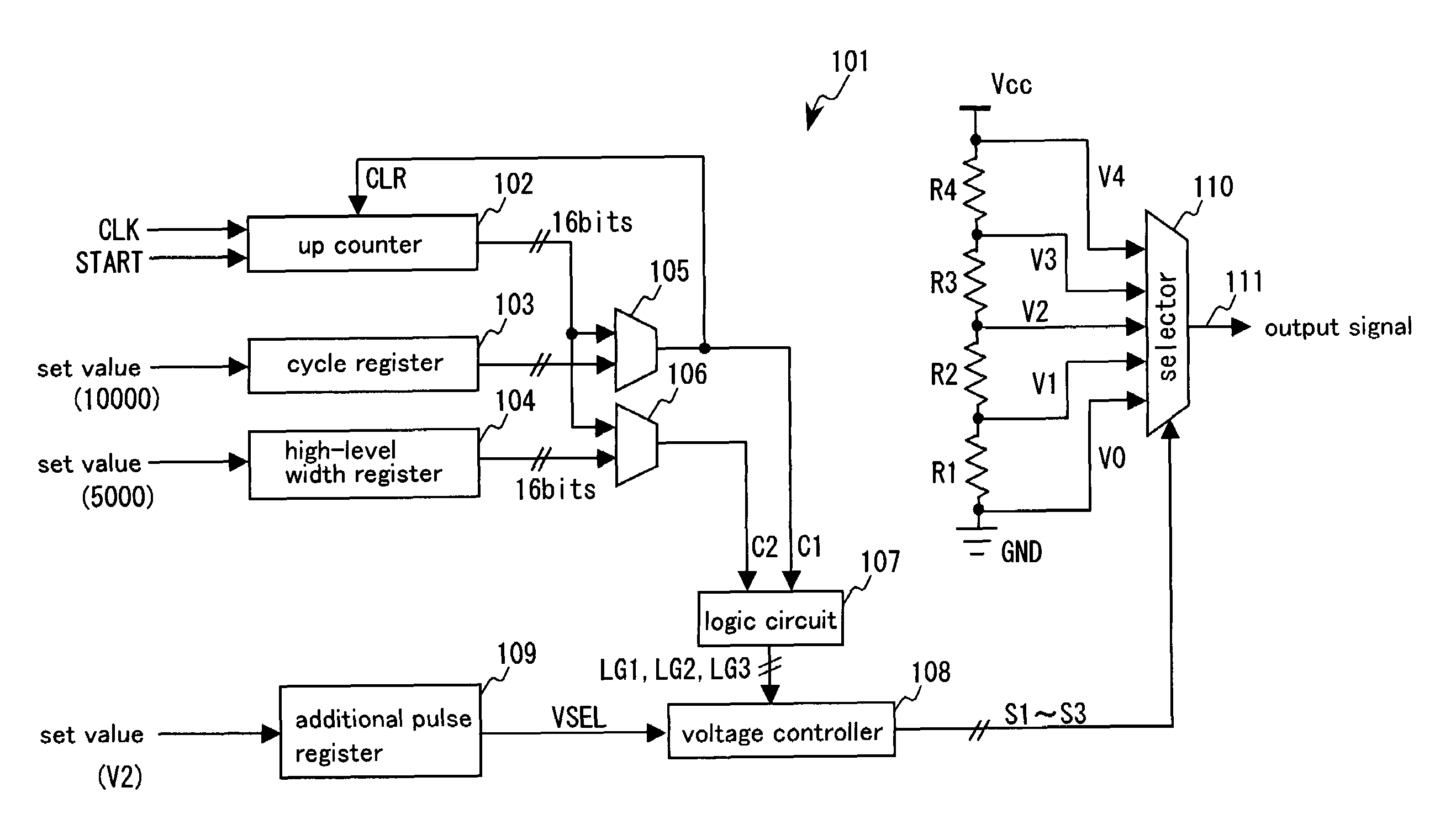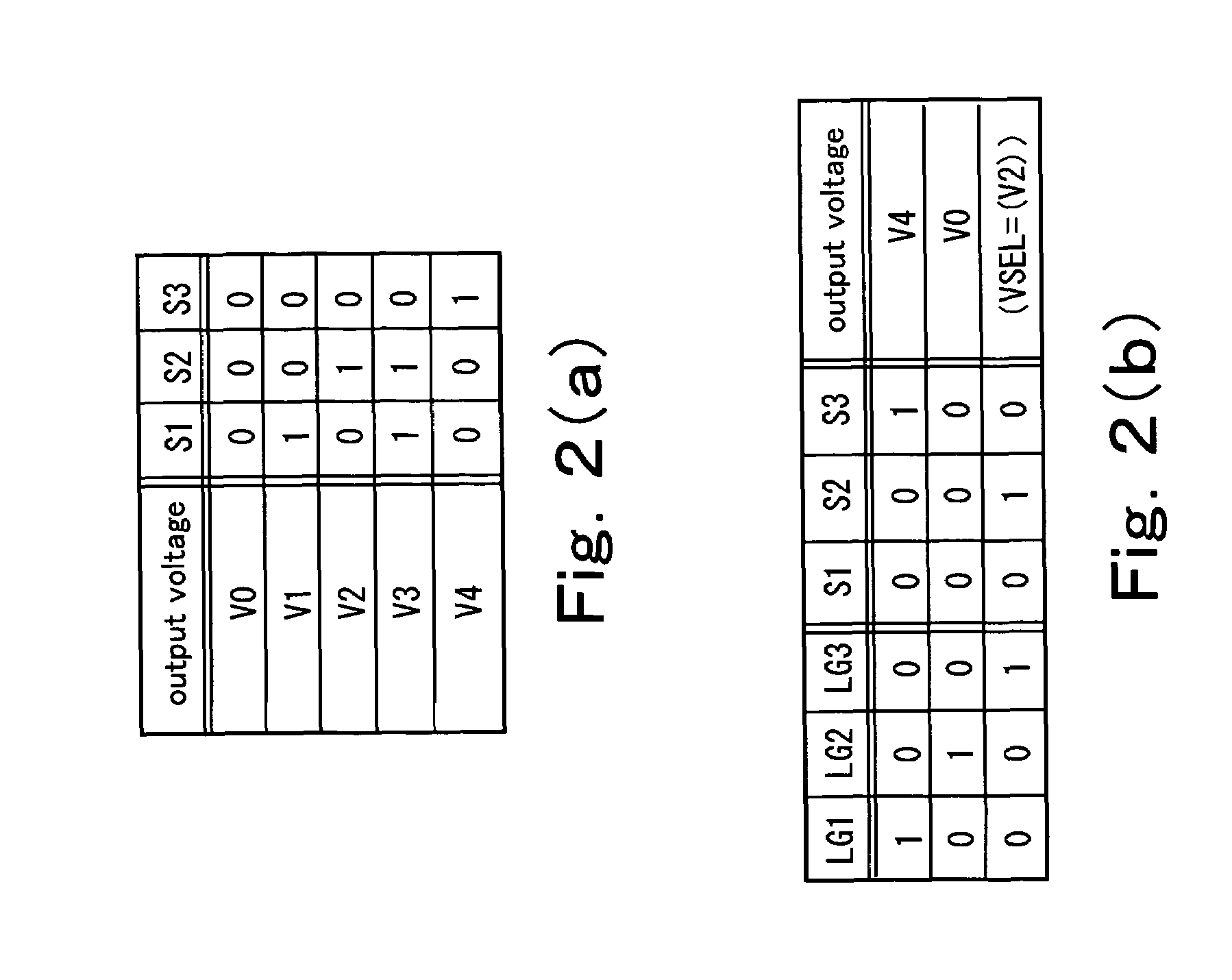Pulse width modulation circuit
a pulse width and circuit technology, applied in the direction of electric variable regulation, process and machine control, instruments, etc., can solve the problems of increasing the decrease of the power supply to the motor and lighting equipment, and the decrease of the rotational speed of the motor and lighting, so as to reduce the influence of load, and slow the effect of the output voltage variation
- Summary
- Abstract
- Description
- Claims
- Application Information
AI Technical Summary
Benefits of technology
Problems solved by technology
Method used
Image
Examples
first embodiment
[0034]FIG. 1 is a block diagram of a PWM circuit by a multi-rate method according to a first embodiment of the present invention. A multi-rate PWM circuit 101 includes an up counter 102, a cycle value register 103, a high-level width register 104, comparators 105 and 106, a logic circuit 107, a voltage controller 108, an additional pulse register 109, a selector 110, and resistances R1, R2, R3, R4 constituting a voltage divide resistance circuit. Reference clocks CLK, a start signal START, and set values are assumed to be supplied from an exterior such as an oscillator and a CPU.
[0035]When the start signal START is inputted, the up counter 102 increments in synchronization with every reference clock CLK to output a 16-bit count value. The count value is set to 0 (zero) in an initial state of the up counter 102 and when a clear CLR signal is inputted from the comparator 105, the count value is reset to 0 (zero).
[0036]For example, the cycle value register 103 registers therein 10000 a...
second embodiment
[0053]Next, a PWM circuit by a multi-rate method according to a second embodiment of the present invention is shown in FIG. 6. The same reference symbols are used to designate the same elements as those of the first embodiment in FIG. 1. A multi-rate PWM circuit 201 is different from the first embodiment in that it additionally includes an additional pulse width register 202 and a comparator 203 and also includes a logic circuit 204 in place of the logic circuit 107.
[0054]The additional pulse width register 202, for example, registers therein 5002 as a set value in advance, and it constantly outputs the 16-bit set value (5002) to the comparator 203. The comparator 203 judges whether a 16-bit count value outputted by an up counter 102 has reached the set value (5002) registered in the additional pulse width register 202, and when the count value reaches 5002, the comparator 203 outputs a signal C3 with a width corresponding to one reference clock to the logic circuit 204.
[0055]Simila...
third embodiment
[0061]Next, a PWM circuit by a multi-rate method according to a third embodiment of the present invention is shown in FIG. 8. The same reference symbols are used to designate the same elements as those in FIG. 1 and FIG. 6. A multi-rate PWM circuit 301 is different from the second embodiment in a logic circuit 302, a voltage controller 303, and an additional pulse register 304.
[0062]In the logic circuit 302, though the same signals C1 to C3 as those in the second embodiment are inputted thereto, signals generated thereby are four signals LG1, GL2, LG3, LG4. Further, the operation of outputting the signals LG1 and LG2 is the same as that in FIG. 7. As the signal LG3, the same signal as the signal C2 is outputted. The signal LG4 is generated to have a width from a falling edge of the signal C2 with a width t2 to a rising edge of the signal C3 with a width t21. A circuit generating the signal LG4 can be realized by using the SRFF 152 and the inverter 153 described in FIG. 4.
[0063]The a...
PUM
 Login to View More
Login to View More Abstract
Description
Claims
Application Information
 Login to View More
Login to View More - R&D
- Intellectual Property
- Life Sciences
- Materials
- Tech Scout
- Unparalleled Data Quality
- Higher Quality Content
- 60% Fewer Hallucinations
Browse by: Latest US Patents, China's latest patents, Technical Efficacy Thesaurus, Application Domain, Technology Topic, Popular Technical Reports.
© 2025 PatSnap. All rights reserved.Legal|Privacy policy|Modern Slavery Act Transparency Statement|Sitemap|About US| Contact US: help@patsnap.com



